MD Ghost F75
Full Member
- Mar 27, 2022
- 122
- 662
- Detector(s) used
- Fisher F75 LTD
- Primary Interest:
- Metal Detecting
Being new to this site, I’ve been really enjoying seeing what everyone is digging and the stories behind the finds. I’m not going to be that guy that posts old finds to try to get you to think they were “Today’s Finds,” lol, but I do have something that I found in the Fall that I’d like to get some input on. I just read the post earlier of someone trying to ID a possible cannonball and saw that there’s guys on the forum here that are experts at this stuff, so here goes, tell me what you think.
I was given permission to hunt a farm in Hanover, PA. I tell you that with hopes that every detail will help with the identification of what I believe could be a cannonball. My buddy and I were digging a slope in the field bordering the wood line in close proximity to a springhouse. All of the finds within 40 yds of the springhouse were from the 1700’s (tombac buttons, pieces of shoe buckles, a Connecticut Copper, etc). This iron ball was located on the edge of the field about 8-9 inches deep. It is 4 inches in diameter and weighs 8 lbs. I chipped a lot of rust off of it and used a brass brush on it before dabbing a small amount of olive oil on it to get rid of the orange color. I know there are a lot of shotputs and mill balls out there that fool a lot of people, and I may be one of those people, but I have a gut feeling about this thing. There is an obvious seam and lots of pitting on the surface. We did not find any other military items in the field. Any input would be greatly appreciated! Thanks for looking.
I was given permission to hunt a farm in Hanover, PA. I tell you that with hopes that every detail will help with the identification of what I believe could be a cannonball. My buddy and I were digging a slope in the field bordering the wood line in close proximity to a springhouse. All of the finds within 40 yds of the springhouse were from the 1700’s (tombac buttons, pieces of shoe buckles, a Connecticut Copper, etc). This iron ball was located on the edge of the field about 8-9 inches deep. It is 4 inches in diameter and weighs 8 lbs. I chipped a lot of rust off of it and used a brass brush on it before dabbing a small amount of olive oil on it to get rid of the orange color. I know there are a lot of shotputs and mill balls out there that fool a lot of people, and I may be one of those people, but I have a gut feeling about this thing. There is an obvious seam and lots of pitting on the surface. We did not find any other military items in the field. Any input would be greatly appreciated! Thanks for looking.
Attachments
-
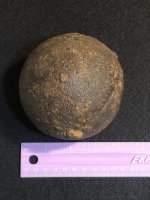 96907ED6-6899-4F76-BF39-B94BDCE31FFE.jpeg1.1 MB · Views: 157
96907ED6-6899-4F76-BF39-B94BDCE31FFE.jpeg1.1 MB · Views: 157 -
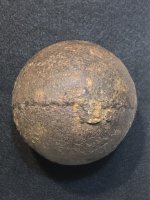 B9F34C34-4575-4BF5-B33E-6BB06CC6C5C9.jpeg1.1 MB · Views: 34
B9F34C34-4575-4BF5-B33E-6BB06CC6C5C9.jpeg1.1 MB · Views: 34 -
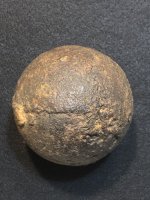 0376DB41-1ADB-42D7-B962-D746370AF5D5.jpeg1.2 MB · Views: 31
0376DB41-1ADB-42D7-B962-D746370AF5D5.jpeg1.2 MB · Views: 31 -
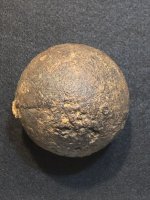 ABB2DFAE-FC67-4B9C-B05D-C64662AAEB58.jpeg1.3 MB · Views: 32
ABB2DFAE-FC67-4B9C-B05D-C64662AAEB58.jpeg1.3 MB · Views: 32 -
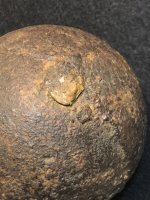 86B7546E-CB8D-486B-B45A-72C10B7E3E6A.jpeg1.2 MB · Views: 35
86B7546E-CB8D-486B-B45A-72C10B7E3E6A.jpeg1.2 MB · Views: 35 -
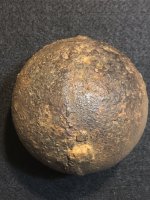 2694C6A5-6D93-4337-8839-7FA62FF177F7.jpeg1.2 MB · Views: 34
2694C6A5-6D93-4337-8839-7FA62FF177F7.jpeg1.2 MB · Views: 34




